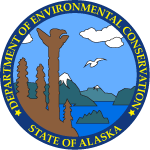| Action Date |
Action |
Description |
DEC Staff |
| 3/17/1986 |
Update or Other Action |
IRP Phase II, Confirmation/Quantification Stage 1 March 17, 1986 (Dames & Moore).
Site SP-14
One well, W-17, was installed near this MOGAS spill site. Water analyses found no detectable TOC or lead in this well, and oil and grease was only slightly elevated at 4.7 mg/L. Specific conductance, at 268 umhos/cm, is also only slightly above inferred background. The soil samples at this site, however, indicate the area may be contaminated. Oil and grease was elevated at 30 feet in W-17 (0.92 mg/g), although it was undetectable at 35 feet. Lead in both samples was three to four times the detection limit for soils.
Extent of Contamination at Site SP-14
Most of the results of analyses from W-17, the one well installed near the site of this MOGAS spill, are very near inferred background levels; however, the detection of oil and grease in a soil sample from 30 feet suggests relatively deep contamination. The site is close to base well No. 1, and although it is probably upgradient from that shallow well, the contaminant plume from Site SP-14 may intersect the well's cone of depression. Such a situation could pose a human health hazard.
Sites SP-7, SP-10, SP-5, SP-12, FT-1, SP-2, and SP-14
The major alternatives at these spill and fire training sites include resampling and analysis for indicator parameters, performing more sophisticated chemical analyses, installing additional monitor wells, and performing an HNU survey. A second round of sampling would either confirm the previous results, indicate a problem with sampling techniques and/or analytical methods, or indicate seasonal fluctuations in contaminant concentrations. More sophisticated chemical analyses would allow identification of the specific chemical species responsible for positive results on indicator tests. This type of analysis is especially significant for such
parameters as TOX and oil and grease, which can show positive results for a large number of organic species of widely differing toxicities.
The species indicated by TOX could be defined by analyzing for purgeable halocarbons (USEPA Method 601). Fuel contamination indicated by oil and grease would best be defined by analyzing
for purgeable aromatics (USEPA Method 602). The large number of samples, and the questions that may be answered by reanalysis of indicator parameters, may make more sophisticated analyses premature at this time. The Phase II, Stage 1 wells at the spill sites under Consideration are considered adequate to determine the presence of contamination at these sites. Additional wells may be required during a future stage to determine the extent of the contamination. An HNU survey could be employed to delineate the areal extent of near-surface organic contaminants resulting from the spill sites.
After establishing sampling grids at each site, shallow auger borings (less than 5 feet deep) would be drilled with a small drilling rig or similar equipment. The soil cuttings on the auger would be inspected for any signs of contaminants. After inspection, small diameter PVC pipes equipped with caps would be inserted into the borings, the borings would be backfilled, and soil gases would be allowed to collect for 2 or more days within the PVC pipes. Subsequently, HNU readings would be taken from the pipes and plotted to define the concentration gradients of soil gases. This method would be appropriate at sites where organic contaminants infiltrated through the ground surface and where the HNU was sensitive to the contaminants in question.
Oil and grease in soil samples from Sites SP-7 and SP-10, FT-1, SP-14, IS-1, and adjacent to Site SP-11 indicate soils are contaminated at Elmendorf AFB. At FT-1, oil and grease was found as deep as 45 feet; at SP-11, it was found in the adjacent wetland. Runoff from contaminated soils could threaten surface water in the area; recharge or ground water movement through contaminated soils could contaminate the local water supply.
Surface water was not sampled during this study, but it is potentially threatened near SP-11, where oil and grease was found in a soil sample (G-l) and by the discharge of contaminated ground water, especially to Cherry Hill Ditch (Site D-17) and Ship Creek. Surface water contamination could threaten the fish hatchery on Ship Creek.
An explosion hazard was found at Sites SP-5, D-5, and D-7 by explosimeter readings. The hazard is probably from spilled fuel at Site SP-5 but may be from fuel or from landfill generated methane at Sites D-5 and D-7.
[ |
Louis Howard |
| 3/1/1988 |
Update or Other Action |
Phase II Confirmation/Quantification Stage 2 March 1, 1988 (Dames & Moore).
Site SP-14
Site SP-14 is the location of a 1,500-gallon MOGAS spill at a former service station near Bldg. 11-110. One monitor well, W-17, was installed during the Phase II, Stage 1 investigation to a depth of 50.5 feet, south of the assumed location of the station. A second well, GW-7A, was
installed during the Phase II, Stage 2 investigation, approximately 200 feet hydraulically downgradient of the station, based on available data. The well locations are shown on Plates 2 and 12.
The subsurface materials encountered in well W-7 consisted primarily of sand with varying amounts of gravel and silt. Water was encountered at a depth of 28.0 feet on 19 June 1984. Analyzed soil samples contained 29 and 31 percent moisture. In well GW-7A, subsurface materials consisted of approximately 8 feet of silt overlying sand with varying amounts of gravel
and silt. Water was encountered at a depth of 31.0 feet (10 September 1986). J In well W-17, HNU readings were 8 ppm at 5 feet and 40 ppm at 15 feet. In well GW-7A, HNU readings were nil throughout the boring.
Samples of ground water from spill sites SP-7, SP-10, SP-5, SP-12, SP-11, SP-2, andSP-14 were analyzed for purgeable aromatics, TDS, and petroleum hydrocarbons. Water from monitor well W-17, installed near this MOGAS spill site, was found to have oil and grease at a concentration of 4.7 mg/L during the Stage 1 investigation. During Stage 2, purgeable aromatics were below
detection in W-17 and newly installed GW-7A. Petroleum hydrocarbons were not detected in either well. A gradient of 48 feet per mile to the south-southwest, as shown on Plates 21 and 22, was calculated for Site SP-14.
The current set of analytical data which represents ground water collected at this site suggests that the subsurface water has not been effected by the MOGAS spill. This is indicated through the absence of petroleum hydrocarbons and purgeable aromatics. However, since a base well (BW-52) is located downgradient of the spill area, resampling of the ground water is recommended in order to confirm the current set of analysis.
SITES WHERE FURTHER ACTIONS ARE DEEMED UNWARRANTED (CATEGORY 1)
Based on the results of sampling and the analytical data generated during the Phase II, Stage 2 investigation, it is recommended that all sites be considered for further action. The current set of analyses suggest that two sites may be likely candidates for Category 1. However,
resampling of these sites is recommended to confirm that minimal or no ground water contamination is present in these areas. The sites that may warrant no further action are: SP-12 and SP-14.
Site SP-14
The reported quantity of the spill, 1,500 gallons of MOGAS at a former service station located near Bldg. 11-110, occurred in 1965. The current levels of petroleum hydrocarbons (3.5 mg/L) in the downgradient well is not believed to present a threat to base well BW-52. A resampling and analysis for petroleum hydrocarbons (USEPA 418.1), TDS (USEPA 160.1), pH, temperature, and specific conductivity is needed to confirm current analyses. It is anticipated that the reanalysis will be similar to that reported on Table 4 and, therefore, the site will be reclassified as Category 1, no further action. |
Louis Howard |
| 8/2/1988 |
Update or Other Action |
Operable units' source area numbers that correspond to RCRA SWMUs from the RCRA RFA. Spill Sites: SS49 SP-14 Mogas spill - near Bldg. 11-110 (now bldg. 8549). Located at the former service station (aka Propulsion Shop aka Jet Engine Shop, Bldg. 11-110 JP-4 and 11-130 Engine oil)near Bldg. 11-110 at the corner of 36th. st. and P st. at the site of the old Bldg. 1892.
In 1965 - 25,000 gals of mogas. MW installed have reported presence of oil & grease (W-17), petroleum hydrocarbons (GW-7A). Further investigation is needed to determine source and exent of
contamination, and will be included in the Ship Creek RFI. |
Louis Howard |
| 4/6/1989 |
Update or Other Action |
TELEPHONE MEMORANDUM USAF Elmendorf AFB EDB Levels Detected at Elmendorf AFB B&V Project 13833
B&V File April 6, 1989
To: Max Schewenne Alaska Department of Environmental Conservation (907) 563-6529
Recorded by J.L. Frizzell Vb
I talked with Max regarding the levels of EDB detected at Elmendorf AFB. There are no drinking water regulations regarding the level of EDB in drinking water. The State of Alaska requires an excess cancer risk calculation be calculated. If the excess cancer risk is less than 10-6 , it
is probable that the EDB concentration is not of concern. If the level is greater than 10-6 , a site by site review will be conducted by the Alaska Department of Environmental Conservation. |
Max Schwenne |
| 5/1/1990 |
Update or Other Action |
Stage 3 RI/FS Table 2 SP-14 MOGAS Spill, Lead slightly exceeds cleanup goal, EDB (ethlylene dibromide aka dibromomethane) also detected in groundwater. Recommended action - no further action. Rationale: Site adequately characterized to determine no significant impact to human health or environment will occur. Figure 4.2.17.7 1,2-dibromomethane (EDB) concentration at SP14-02 0.046 ug/L (Stage 3) and in well W-17 0.035 ug/L (Phase II Stage 1) NOTE To FILE: Table C cleanup level in groundwater is 0.00005 mg/L or 0.05 ug/L. Lab method used was method 504.
4.2.17.2.1 Loss of Samples
No soil or water samples collected for laboratory analysis were lost from Site SP-14; however, the water samples originally submitted to the laboratory for EDB analyses were not analyzed due to laboratory oversight. Holding times were exceeded by the time the laboratory realized the oversight, and the analyses were not performed.
4.2.17.3 Significance of Findings
Analytical methods detected petroleum hydrocarbons in subsurface soil and EDB and lead were detected in groundwater samples from Site SP-14. Dissolved lead levels detected in groundwater at the site exceeded its MCL of 0.05 mg/L. Petroleum hydrocarbon concentration of 3.5 mg/L was
detected in groundwater samples from well GW-7A in a 1986 sampling effort (Dames and Moore, 1987). Petroleum hydrocarbons were not detected in water samples collected during the 1988 field
investigation.
EDB was detected at concentrations of 0.035 ug/L and 0.046 ug/L from well W-17 and well SP14-02, respectively. A maximum contaminant level does not exist for EDB; however, EDB in drinking water is of concern because of its associated cancer risk factor. The probable source of petroleum hydrocarbons in the soil and EDB and dissolved lead in the water at this site is a MOGAS spill of 1500 gallons that occurred in 1965 at the site.
4.2.17.3.1 Zones of Contamination
The data density at the site allows for some generalization of the zones of contamination. A soil gas survey at Site SP-14 showed detectable BTX and unidentified organics contamination throughout the area. This contamination was also detected by HNu equipment in the field during drilling of well SP14-01. Laboratory analysis confirmed the presence of petroleum hydrocarbons at the 30-foot depth in this boring. Analyses also showed contamination by 2-butanone in subsurface soil at well SP14-02.
General concentration lines have been constructed for the soil gas data, but there is insufficient data from other sources to allow three-dimensional temporal or higher-definition spatial mapping. Water samples analyzed from well SP14-02 completed as part of this study and from well W-17 installed previously did indicate contamination by EDB. Lead was detected in water samples from all 4 of the wells at Site SP-14.
4.2.17.3.2 Contaminant Migration
Lead is migrating in the groundwater, as evidenced by the higher concentrations of this metal in downgradient wells including well GW-7A and well SP14-01 at Site SP-14. EDB was detected in well W-17 and well SP14-02 but not in well GW-7A or well SP14-01 (both of which are within about 200 feet of and downgradient of well W-17). The concentration of EDB in well SP14-02 (which is more than 700 feet removed from W-17) is slightly higher than that in well W-17. Although the boundaries of the site have not been clearly identified, past reports indicate that the spill occurred near the intersection of "P" and 36th Streets (Phase II Stage 2 Report, Dames and Moore 1988).
4.2.17.3.3.2 Source and Release Characterization
Petroleum hydrocarbons, EDB and lead were released to the environment most likely as the result of a motor-gas (MOGAS) spill. Approximately 1500 gallons of fuel were spilled and none was recovered.
4.2.17.3.3.9 No Threat to Health
Groundwater samples collected in 1988 were not contaminated above State of Alaska primary standards for organic compounds. The EDB detected had an associated excess cancer risk factor higher than the 10-6 value cited by ADEC as a level of regulatory concern. Lead was detected at levels exceeding the State of Alaska standards of 0.05 mg/L by up to 0.016 mg/L. |
Louis Howard |
| 1/25/1993 |
Update or Other Action |
Closure of State-Elmendor Environmental Restoration Agreement (SERA) Site LF-12, Johnson's Camp Landfill
1. A 1983 Installation Restoration Program (IRP) Phase I report for Elmendorf AFB reported the existence of an inactive construction and demolition refuse disposal site known as D-12,
(renamed LF-12) the Johnson's Camp Landfill. The identification and location of the landfill was based on anecdotal evidence such as interviews with unnamed base personnel. No visual evidence of contamination was found. The 1983 report indicated the site was used in the late 1940's and early 1950's, consisted of less than one acre in total area, and was closed and landscaped with local soils. A map of the site area is attached.
2. No evidence of waste disposal activities in the alleged area was found. A review of aerial photographs from the years 1950, 1962, 1972, and 1982 revealed no disturbance to topography ot
vegetation typical of landfill practices.
3. A boring was performed in 1988 to facilitate monitoring well installation for another source area. This boring, designated SP14-02, was placed in the purported location of LF-12 to a depth
of 45 feet. The attached boring log reveals no evidence of landfill activities in the boring location. Undisturbed sandy gravels typical to the developed portion of the base underlie the
alleged LF-12 area.
4. An additional boring was performed on the eastern edge on the site in 1992 under similar circumstances. This boring, known as OU5MW-07, also revealed no evidence of landfill activities.
5. Given the lack of evidence for any waste disposal in the alleged LF-12 area, Elmendorf AFB proposes this site be closed in accordance with the SERA. If evidence of waste disposal
activities in the LF-12 area is discovered your office will be notified and site investigation activities under SERA will be resumed. |
Jennifer Roberts |
| 11/18/1994 |
Enforcement Action |
Notice of Violation Sent to Lt. Col. Lawrence E. Boese Sections 3007(a) & 3007(c) of RCRA AS Title 46 chapter 03 Section 020. Violation #5: 40 CFR 262.34(a)(4) [as adopted by 18 MC 62.210 & authorized by AS 46.03.020, AS 46.03.296, AS 46.03.299, AS 46.03.305, & AS 46.03.311] requires a generator of hazardous waste to comply with the requirements for Preparedness & Prevention, Contingency Plan & Emergency Procedures, Personnel Training, & Waste Analysis requirements of 40 CFR 265 Subparts C & D, 40 CFR 265. 16, & 40 CFR 268.7(a)(4) respectively. USAF Elmendorf AFB (USAF EAFB) failed to comply with the following requirement:
40 CFR 265.35 requires generators of hazardous waste to maintain aisle space to allow the unobstructed movement of personnel, fire protection equipment, spill control equipment, & decontamination equipment to any area of facility operation in an emergency, unless aisle space is not needed for any of these purposes. USAF EAFB failed to maintain adequate aisle space for the movement of inspection personnel or emergency equipment at the < 90 day hazardous waste accumulation area located inside the Jet Propulsion Lab Safety Storage Shed at Bldg. 11-110.
USAF EAFB must ensure the adequate aisle space is provided at all hazardous waste accumulation areas, including the Safety Storage Shed at Building 11-110. Please inform the Department when this has been accomplished. |
Janice Adair |
| 11/24/1997 |
Leaking Underground Storage Tank Release Confirmed - Petroleum |
LUST Site created in CSP for source area ID 77288 |
Former Staff |
| 11/24/1997 |
Leaking Underground Storage Tank Cleanup Initiated - Petroleum |
Three UST were removed from the ground. Approximately 1200 cy of DRO contaminated soil was sent to Alaska Soil Recycling for treatment. 200-300 cy placed back into UST excavation after confirmation sampling confirmed contamination was less than category "B" cleanup standards. |
Louis Howard |
| 11/24/1997 |
Site Added to Database |
|
Former Staff |
| 11/25/1997 |
Site Closure Approved |
Site closed out contaminant levels below applicable cleanup levels. |
Louis Howard |
| 7/6/2011 |
Exposure Tracking Model Ranking |
Initial ranking with ETM completed for source area id: 77288 name: autogenerated pm edit - Elmendorf - AFID 127, 128 & 129 |
Louis Howard |




